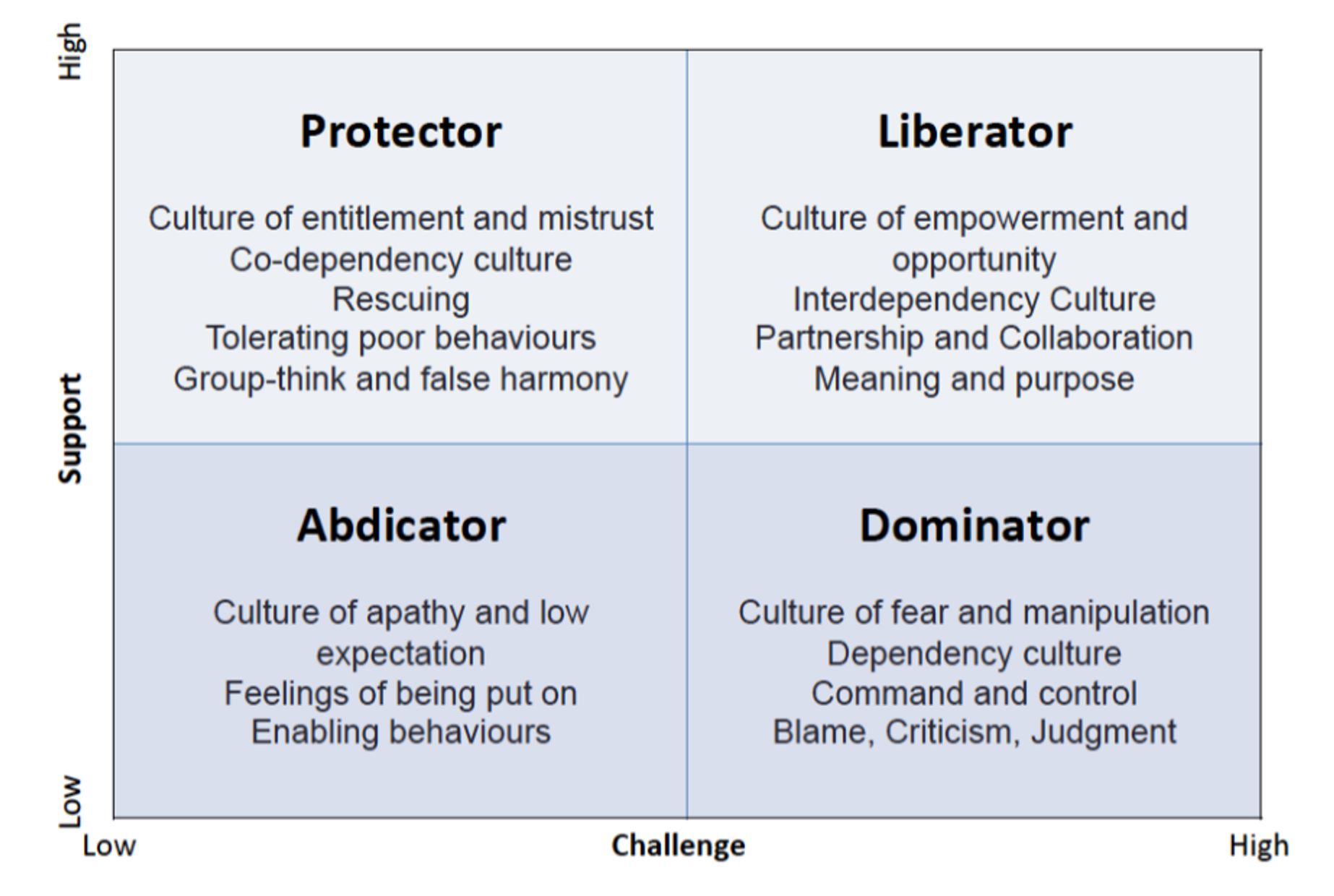14 Finding the Right Balance: Support or Challenge?
Carson Rein

Exploring the Support Challenge Matrix
The “Support Challenge Matrix,” created by Ian Day and John Blakey, offers coaches insight into the balance between providing support and issuing challenges to students.
Identifying the starting point (status quo) will be important for you, as an academic coach, in identifying the level of support each student needs and the level of challenge recommended to achieve ‘high performance.’ Is the student you are coaching struggling in a single class? Is there an entire semester that has caused the student to be at risk of losing a scholarship? Are they experiencing barriers to educational opportunities they thought they had access to? Why did they come to college? What do they want to get out of this experience?
By using the Support Challenge Matrix and your prior knowledge from the How to Have a Coaching Conversation section, you can identify the student’s strengths and weaknesses, and work with the student to develop a plan of action. Finding the balance between supporting weaknesses and challenging strengths is the recipe for coaching success.
The Support Challenge Matrix
This matrix is measured by levels of support and levels of challenge students experience and categorizes student behavior into four quadrants: Inertia/Apathy, Cosy Club, Stress, and High Performance. An inverted relationship exists between what a student experiences and the recommended steps for a coach. For example, if the student feels challenged, the coach can offer support; if the student feels unchallenged, the coach may find a challenge to give the student to encourage personal growth.

First, let’s look at the two metrics that create the matrix: Support and Challenge, and then we will introduce each of the four categories presented in the matrix.
Support Measure
When students don’t feel supported or challenged, they get complacent. They might hesitate to take risks or not take any at all. When that lack of support is mixed with challenging situations, it can lead to stress, making it even harder for them to step out of their comfort zone. Supporting students through challenging situations and navigating the services/resources on campus is an effective coaching foundation. These topics may be more sensitive, and personal, so it is important to remember your college’s policy on over-disclosure and mandatory reporting expectations. Refer to our When Students Over-Disclose section for more information on navigating these conversations.
Challenge Measure
Challenging your students can be tricky. Consider Simon Sinek’s testimony of when strength was found in one of his weaknesses.
The Simple Way to Find Strength in Your Weakness – Simon Sinek
Your role as a coach is to help them navigate the challenges they experience. Challenging students is a strategy directed primarily by the student. In a coaching setting, challenging your students will come in two forms: support and growth.
- Support by challenging them to seek student success services on campus to receive support by encouraging services and resources like the writing center, the math lab, and peer tutoring programs. You show them how to find strength in their weaknesses.
- Growth by challenging them to seek personal growth by exploring course and degree programs, internship and career opportunities, and community resources and services that enhance their learning experience. You are helping them to become self-directed advocates for their journey.
Inertia/Apathy (Low Challenge and Low Support)
When a student starts from a place of feeling unmotivated or disengaged, it can be harder for them to connect with their classmates and campus resources. This can make it difficult for them to advocate for themselves and fully participate in their education. Students in this situation may struggle with their grades, withdraw from classes more often, and feel disconnected from the support available on campus. It is important to provide extra encouragement and assistance to students who are experiencing this lack of motivation, so they can thrive in their academic journey.
Suggestions for Coaches
Students in the Inertia/Apathy quadrant may need support in navigating mental health and/or counseling services, educational disability resources, academic advising, and student success services. Refer to the Building Bridges chapter for more information on leveraging these services.
Support students by:
- Having exploratory conversations: Does their selected degree program align with their career aspirations? Are the students disconnected because they are not interested in the degree program? Is there another degree program that is worth exploring?
- Finding the student’s “Why?” – Is it something they are truly passionate about? Or are they trying to satisfy a parental figure?
- Reminding students that seeking support services facilitates success, and also allows them to network with students and other professionals in their degree field.
Challenge students to:
- Explore degree programs and courses offered at your university.
- Use their creativity to take a specific focus on their degree. ‘Electives’ can receive approval to apply to degree requirements.
- Explore internship and career opportunities and explore their interest in the degree fields.
‘Cosy’ Club (Low Challenge and High Support)
Welcome to the ‘Cosy Club’ where students feel comfortable and at ease with their current performance. In this quadrant, students rely on external support and thrive on consistent nurturing. While it may seem cozy and inviting, students need to remember that personal growth comes from pushing themselves beyond their comfort zones and seeking out challenges that can help them grow and develop.
Within the ‘Cosy Club’, students often receive praise and encouragement for their performance, which can sometimes hinder their growth potential. Some students in this category may not even be aware of their strengths and how they can leverage them for future career opportunities. Instead, they may be simply going through the motions of their academic program without a clear understanding of their career path.
Suggestions for Coaches
To break out of the ‘Cosy Club’ mindset, students need challenges that push them to explore their strengths and interests. These challenges should help students gain insights into potential career paths that align with their strengths, ultimately helping them make informed decisions about their future.
You aim to work together to help students in the ‘Cosy Club’ mindset step out of their comfort zone and discover their full potential. Reference the Building Bridges section when navigating these challenges.
Challenge students to:
- Set SMART goals that challenge their current workload. Goal setting leads to action, action is the first step to getting out of their comfort zone.
- Explore community resources to encourage growth, this is a great opportunity for them to expand their professional network.
- Explore internship and career opportunities, this may give cozy students a new perspective to take new classes or change their degree focus.
Stress Zone (High Challenge and Low Support)
Whether your student accidentally leaves their assignment until the last minute, gets stuck with the toughest part of a group project, or just feels like they are not getting the support they need, you may find your student in the stress zone. It can be tough for a student to feel like they are on their own, as it can make taking risks and sharing ideas much harder. Students in the stress zone do not struggle with taking on new challenges, but their intuition to take on new projects leads to an overloaded schedule.
Suggestions for Coaches
While some students thrive under pressure and perform better when stressed, other students who feel a lack of support can experience a real roadblock to getting things done. It is all about finding that balance and reminding students that it is okay to ask for help when they need it.
Support students by:
- Recommending time management and priority management skills is essential. Classes, meetings, appointments, and other time commitments as a college student can be overwhelming, organizing these commitments is an effective stress-reducer.
- Reminding your students that it is okay for their interests to change, the job they thought they wanted might not be the same job they are passionate about. Having it all figured out right now is not a requirement.
- Recommending tutoring services such as the math lab and writing center. This is an effective tool to reduce stress in preparation for an exam.
High Performance (High Challenge and High Support)
Finally, let us talk about the high-performance quadrant. This quadrant is where the magic happens for student success. When students formulate the right balance between challenging themselves and receiving support, the opportunity for real growth happens. It is all about finding that sweet spot where students can explore new ideas without worrying about making mistakes.
High-performance students embrace failure as a learning opportunity, not a reflection of inadequacies in their abilities. They are not afraid to come up with a hypothesis, test it out, and refine it based on the results. Failure motivates them to get creative and problem-solve to resolve the task at hand.
Suggestions for Coaches
As academic coaches, your main goal is to help your students become high-performing individuals who are ready to take on any challenge that comes their way. You are simply the supporting cast helping them reach their full potential.
Continue supporting and challenging your students by:
- Encouraging commitment to community organizations to encourage growth, expand their network, and expand their educational perspective.
- Encouraging consideration of internship and career opportunities.
- Empowering them to continue taking steps that promote resilience and a growth mindset. Refer to the Helping Students Build Resilience section for more resources on this topic.

How Do You Lead?
“What is it like to be led by you?”
This important question from the Leadership Coaches is worth thinking about. Many leaders fail to reflect on their leadership qualities which is an important step in becoming an effective leader. Look at the following matrix and identify which pattern best fits your leadership style.
Coach’s Perspective: Support Challenge Matrix

Balancing the Right Level of Support
In my days as a rookie coach, I found myself wanting to be so deliberately hands-on. I helped one student revise their resume myself, I also revised a scholarship application essay for another student. After some reflection, I found myself providing high levels of support without challenging students to learn how to navigate support services themselves. I wanted to do all the work, but at the end of the semester I couldn’t help but think, “I hope they learned how to do this themselves.”
As a coach, your role is focused on supporting students by understanding their needs and guiding them to the services your campus has to offer. Supporting your students means helping them take the initiative in their academic journey by encouraging them to connect with the right offices on campus. A coach might say, “Did you know this service is completely free for full-time students?” or “Have you heard about the student success services and peer tutoring programs we have?”
Balancing the Right Level of Challenge
Finding the right level of challenge can manifest itself in several ways. I have challenged students to do things ranging from using their email calendar to organize their daily schedule to challenging a student to apply for a departmental scholarship and leveraging their network within their department for letters of recommendation. Consider Simon Sinek’s perspective:
Start with WHY in All Your Conversations – Simon Sinek
Every student you work with brings their unique set of needs and aspirations to the table, and while you might notice some commonalities, it’s important to connect with each individual’s “Why?” Sure, suggesting a campus resource can help answer their “What?”, but uncovering their “Why?” can inspire them to take ownership and set meaningful challenges to achieve their goals.
Bring up new ideas, challenge students to step out of their comfort zone, and enhance their learning experience and personal development. The end goal is to help the student develop a resilient mindset and equip them with foundational skills to confront challenges they may experience in their professional career.
Now let’s talk about coaching types and see if you can identify which describes your style and consider if you are reaching your fullest potential in a coaching role.
Abdicator (Low Support and Low Challenge)
An ‘abdicator,’ provides low support and low challenge to their students. Coaches in this category are enablers, they may encourage a culture of low expectations, or they may encourage ‘just sliding by.’ Unfortunately, this coaching style often doesn’t lead to high levels of success for students, and it may not yield the tangible results needed for an academic coaching program to thrive.
Protector (High Support and Low Challenge)
A “protector” tends to provide high support while keeping challenges low. While this might seem comforting (‘Cosy’ Club), it can lead to a co-dependent relationship where students aren’t fully empowered to make their own decisions. When students aren’t challenged, they may feel a sense of false harmony between what you’re trying to achieve as a coach and their personal goals. Remember, you do not have to ‘rescue’ every student. Your mission is to help your students explore and uncover their passions and coach them along as they navigate the diverse opportunities available to them.
Dominator (Low Support and High Challenge)
The ‘dominator’ is characterized by providing low levels of support but high levels of challenge. This type of coach creates a culture of fear and manipulation. Coaches in this quadrant may overwhelm students with challenges without providing substantial levels of support. Because of the lack of support, students may be hesitant to take risks; thus, they may take conservative action when they need help stepping out of their comfort zone. Dominator coaches should focus on providing more support to their students and let their students know that it is okay to make mistakes. Making mistakes and learning from those mistakes is growth, and growth is a necessary step to success.
Liberator (High Support and High Challenge)
The ‘liberator’ is someone who can find a balance between offering high support and high challenge to students. This kind of coach fosters a collaborative environment that empowers students to reach their full potential. In this setting, coaches challenge students to test their foundational skills to tackle their goals; but also, become comfortable asking for support when they need it. With this balanced coaching style, students are encouraged and comfortable taking risks and feel confident trying new things, knowing that failure isn’t something to fear. Liberator coaches should focus on continuing to challenge their students. Empower them to develop resilience and a growth mindset by challenging them to consider opportunities that they have spent time exploring. Refer to the Promoting Student Resilience section for more tips on maximizing your coaching potential.
Suggestions for Coaches
A key part of academic coaching is recognizing the right moments to provide support and when to challenge students to independently use the resources and services available to them. Use the ‘Coach’s Perspective’ matrix to internally reflect on the strategies you use when working with students. Be honest with yourself, so you can improve your skills and work towards maximizing your coaching potential, and your students can achieve high performance.
References
Sinek, S. (2023a, April 19). The Simple Way to Find STRENGTH in Your WEAKNESS. YouTube. https://www.youtube.com/watch?v=FTPmW1vP3JE
Sinek, S. (2023b, September 18). Start with WHY in ALL Your Conversations. YouTube. https://www.youtube.com/watch?v=h2YDOKBwiGg
Spiske, M. (2018). Brown game pieces on a white surface [Photograph]. Unsplash. https://unsplash.com/photos/brown-game-pieces-on-white-surface-QozzJpFZ2lg
White, I. (2023, November 15). Leading with Support and Challenge. Leadership Coaches: Taking care of leadership. https://www.the-leadership-coaches.com/post/leading-with-support-and-challenge
Öhlander, F. (2018, May 25). Photo by Fredrik öhlander on unsplash. Two people standing on a train window photo – Free Sri lanka Image on Unsplash. https://unsplash.com/photos/two-person-standing-on-train-window-LswLpUWxfbU
Media Attributions
- fredrik-ohlander-LswLpUWxfbU-unsplash
- Picture1
- markus-spiske-QozzJpFZ2lg-unsplash
- 27009712-64a4-47dd-875c-e0ca0574cccd

